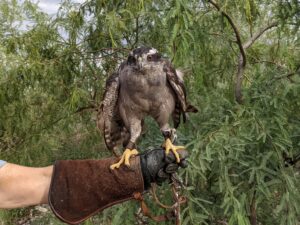Northern Goshawk – Cercei
 Name: Cercei – Female
Name: Cercei – Female
Species: Northern Goshawk
Liberty Arrival: May 2011/Juvenile
Injury/Condition: Fractured right wing
The veterinarian who brought Cercei to Liberty Wildlife had kept the injured bird until the wing healed. Our medical examination found that the left wing also had damage and there was severe feather damage to both healed wings. Determination of her flight abilities had to be delayed for a year until new feathers came in following the annual molt. During the subsequent flight testing, Cercei still was unable to fly any distance. Additional x-rays showed that during the year, both right wing and left wings had changes to the bone structures. Despite physical therapy, the anomalies continued to limit the extension of her wings, allowing her to fly only short distances. Non-releasable now, Cercei was reassigned to the education team.
Northern Goshawk Facts
Description: In addition to being North America’s largest accipiter, the northern goshawk is the most widely distributed accipiter in the world. They are found throughout the mountains and forests of NorthAmerica and Eurasia.
Life span: The oldest known northern goshawk was at least 17 years, 7 months old, based on banding records from Michigan. One review reports a captive northern goshawk living 19 years.
Prey: The goshawk is a powerful hunter capable of killing an extremely wide variety of birds and mammals of varying sizes. Depending on where they live, prey species include mice, shrews, chipmunks, jackrabbits, squirrels, raccoons, foxes, geese, doves, woodpeckers, and crows. Known as a predator of other birds of prey, northern goshawks have been documented hunting red-tailed hawks, owls, and kestrels.
Babies/Nests: Northern goshawks usually choose the largest trees in a stand for nest sites, placing the nest next to the trunk on a large horizontal branch or in a primary or secondary crotch. Goshawks often re-use nests from previous years or appropriate nests of other accipiters. They are monogamous, and pairs typically lay a single clutch of three to four eggs each year. The incubation period lasts 35 to 38 days and young goshawks fledge when they are 36 to 42 days old.
Azor Norteño – Cercei
Nombre: Cercei – Hembra
Especie: Azor Norteño
Llegada a Liberty: Mayo, 2011/Joven
Herida/Condición: Fractura a su ala derecha
El veterinario que trajo Cercei a Liberty Wildlife se quedo con Cercei hasta que su fractura a su ala se había curado. Nuestra examinación medica encontró que su ala izquierda también tenia problemas y había daño severo a las plumas de sus alas. Determinación de su habilidad de poder volar fue retrasada por un año hasta que sus plumas nuevas crecieran. Después de hacer un examen nuevo para determinar su habilidad de poder volar todavía no pudo volar ninguna distancia. Rayos de x adicionales comprobaron que durante el año, sus dos alas tenían cambios de sus huesos estructuralmente. A pesar de terapia física, las anormalidades continuaron y limitaron la extensión completa de sus alas dejándola nada mas poder volar distancias cortas. Sin poder ser realizada al estado salvaje, Cercei ahora esta en el equipo educativo.
Datos del Azor Norteño
Descripción: En adición de ser el accípitre mas grande de Norte América, el azor norteño es el accípitre mas distribuido en el mundo. Se pueden encontrar por las montañas y los bosques de Norte América y Eurasia.
Duración de vida: El azor norteño mas viejo que se ha conocido tenia al menos 17 años con 7 meses, basado en datos de Michigan. Una revisión reporta que había un azor norteño que llego a los 19 años en cautiverio.
Presa: El azor norteño es un cazador fuerte capaz de poder matar una variedad grandísima de pájaros y mamíferos de tamaños variados. Dependiendo de donde viven, su presa incluye ratones, musarañas, ardillas listadas, liebres, ardillas, mapaches, zorros, gansos, palomas, pájaro carpinteros, y cuervos. Conocido como el predador de pájaros de presa, el azor norteño ha sido documentando cazando el halcón de cola roja, búhos, y cernícalos.
Nidos: El azor norteño típicamente escogen el árbol mas grande para sus nidos, poniendo su nido junto al tronco o en una rama horizontal. Los azores norteños típicamente reúsan sus nidos de años anteriores o de otros accípitres.
Crías: Son monógamos entonces las parejas típicamente ponen 3 a 4 huevos cada año. El periodo de incubación dura 35 a 38 días y los jóvenes se van de nido cuando son 36 a 42 días de edad.

